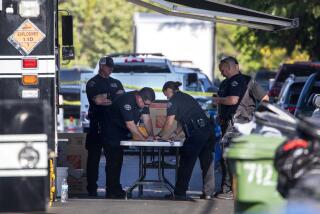Investigators Describe Discovery of Booby-Trapped Drug Lab
Four police investigators fled for their lives after coming across a booby-trapped methamphetamine lab at the Newbury Park home of Bradley Raville earlier this month, a sheriff’s detective testified Monday.
Moving cautiously inside a backyard shed, investigators came upon the trap while opening a door whose handle had been tied to a can of highly flammable chemicals, Ventura County Sheriff’s Det. Richard Barrios testified during a pretrial hearing for Raville.
A lighted blowtorch sat on the floor nearby, apparently placed there to ignite the chemicals when they spilled. No explosion occurred, but the discovery caused investigators to scramble for safety.
“I heard it fall, then I heard a bubbling sound,” said Barrios, who opened the door slowly as three investigators stood behind him. “A gurgling is the best way to explain it. Liquid was coming from a container.”
After spotting a flame inside the room, Barrios said, he turned to Det. Joe Evans.
“I noticed the expression on Det. Evans’ face,” Barrios said. “He had the look of fear.”
Raville, 44, faces 11 criminal counts in connection with the June 11 incident, which prompted the evacuation of several homes. The allegations include four counts of attempted murder of a peace officer and one count of operating a methamphetamine lab.
The attempted-murder charges could result in a sentence of life in prison, prosecutors said. Testimony is expected to continue today, with Superior Court Judge Brian Back to decide if Raville is to stand trial.
Throughout the hearing, Raville, dressed in blue prison garb, scribbled notes and whispered frequently in the ear of his attorney, Jorge Alvarado.
Raville was arrested two years ago in connection with the fatal shooting of Juan Elijio Carranza, a Lancaster tow truck driver. But Raville maintained that the shooting was in self-defense, and sheriff’s officials say they have not gathered enough evidence to prove Carranza was murdered. No charges have been filed.
Meanwhile, authorities say the booby trap discovered this month was rigged to kill anyone who came across it and was powerful enough to blow the adjacent home off its foundation.
*
Monday’s testimony marked the first detailed police description of the incident.
Authorities had arrived late at night at the Rudman Drive home of Raville’s parents, where Raville also lived, after getting a tip that methamphetamine was being produced there. Raville’s father, Clarence, answered the door and gave detectives permission to search the backyard.
They took Raville into custody after finding him in a trailer, seating him on a patio next to the suspected methamphetamine lab.
The lab, according to detectives, appeared to have been constructed in an unfinished addition to the house. Its entryway was covered with a blue tarp.
Barrios said the booby trap was simple: a black cord attached with duct tape to a can of toluene, a volatile liquid used in methamphetamine production. That can rested on one filled with acetone--another volatile methamphetamine ingredient--and both containers were atop a table. The blowtorch, already lit, sat nearby on the floor.
Only a small amount of flammable liquid apparently spilled when officers entered, and it did not catch fire, investigators said.
More high-tech was the elaborate surveillance system detectives said they found inside the lab. According to Barrios, several video cameras were placed around the house, some under eaves and others atop a pole on the roof.
Inside the lab, detectives found a video monitor showing activity outside the Ravilles’ home. And a police scanner was tuned to the Sheriff’s Department’s east county frequency, Barrios said.
*
Meanwhile, numerous other methamphetamine ingredients, including red phosphorous, were discovered, according to William Garvey, a state narcotics investigator who was at the scene.
Deputy Dist. Atty. Chris Harmon questioned Garvey about the chemicals and equipment.
“Would you have lit an open flame in there?” Harmon asked.
“No, I wouldn’t have,” Garvey said. “I wouldn’t know what would happen, or if I’d make it out of the room.”
More to Read
Sign up for Essential California
The most important California stories and recommendations in your inbox every morning.
You may occasionally receive promotional content from the Los Angeles Times.









